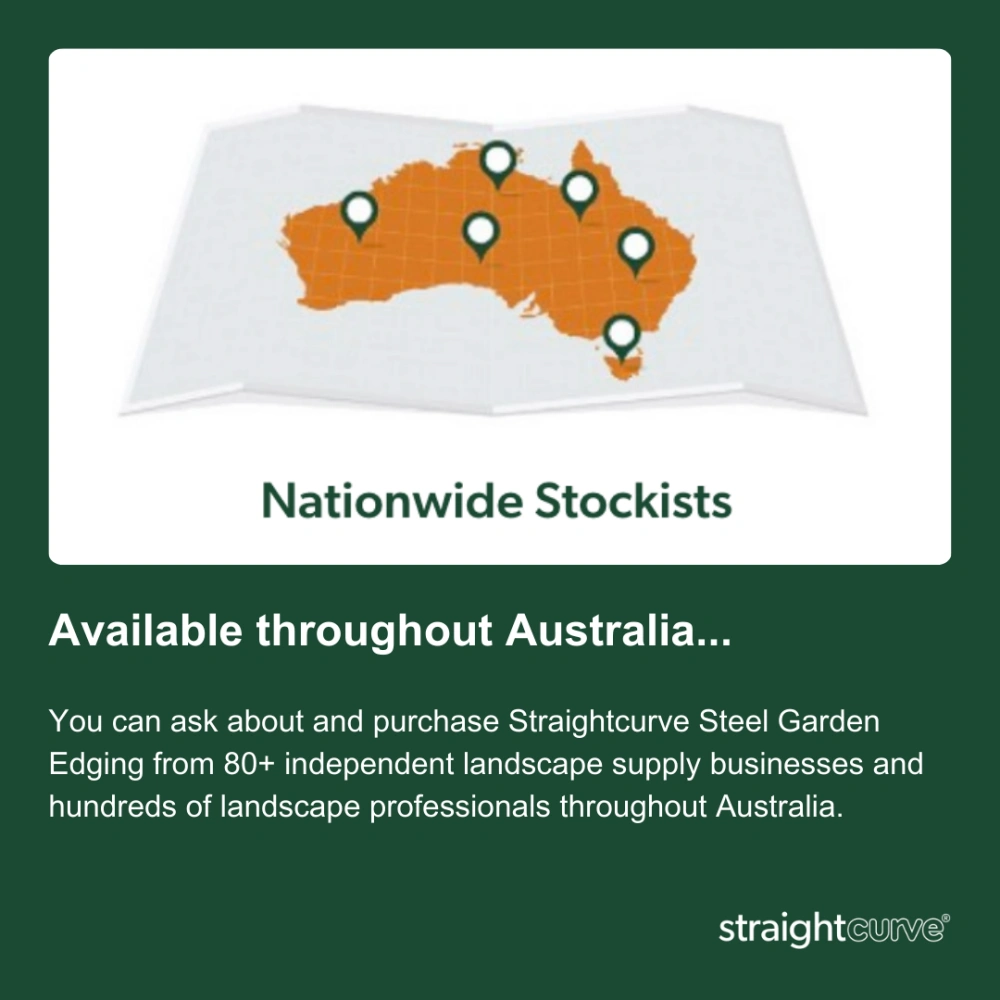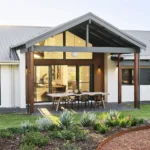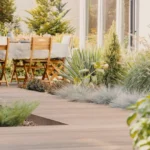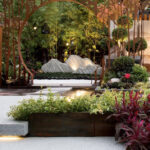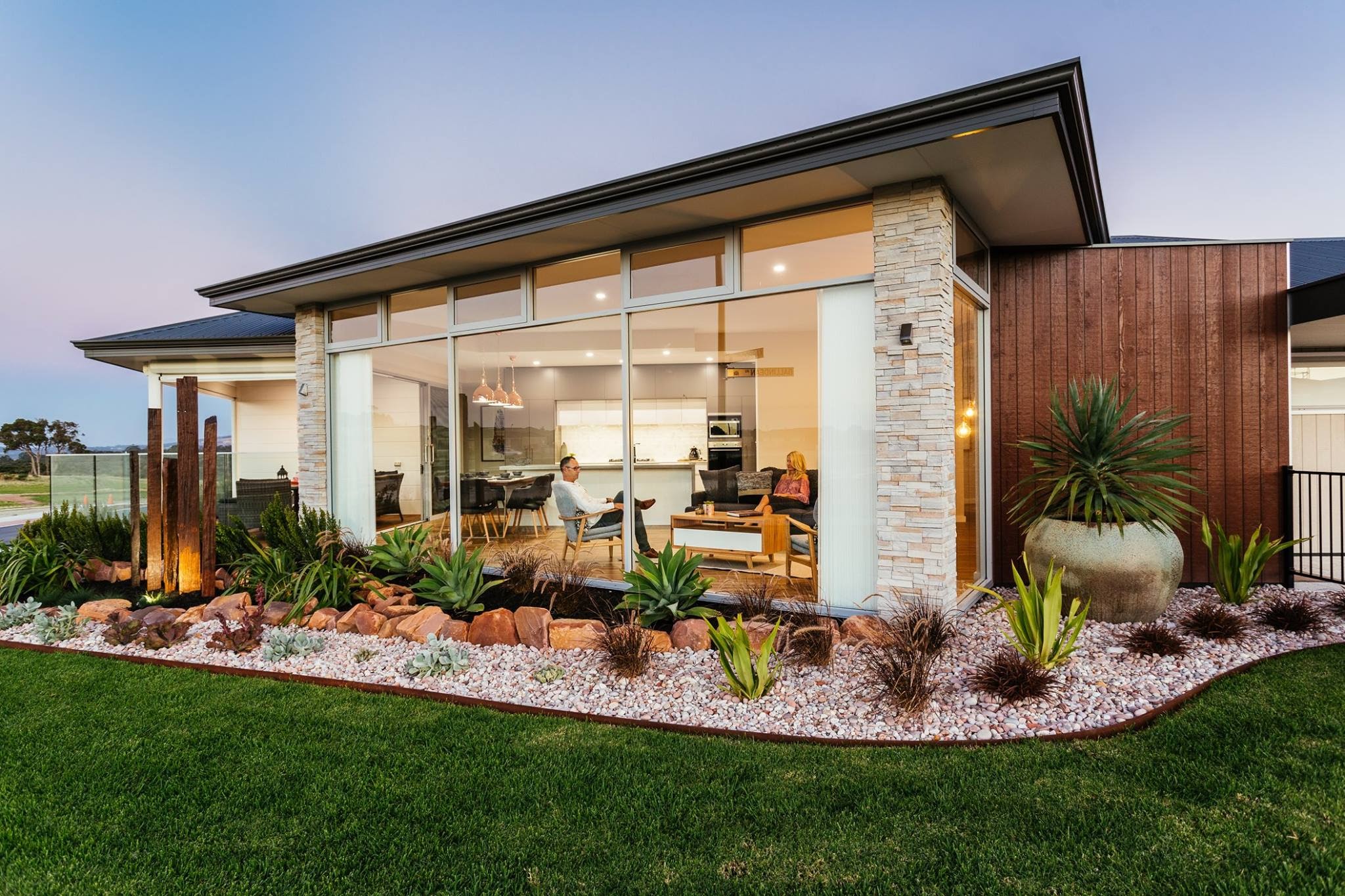
Garden Edging: A DIY Gardener’s Essential Guide
Introduction.
Quality Garden Edging helps you create & maintain beautifully designed, well-maintained gardens that are a joy to look at and spend time in.
Grass will always try to grow beyond any lawn borders you dig (if there’s nothing to stop it). Mulch and soil are prone to blowing over lawn and pathway edges (unless there’s a barrier to prevent that). Gardens that use quality garden edging look neater for longer and take less effort to maintain than those that don’t.
Keeping a growing garden looking good is a commitment that takes time and effort. However, the smart use of well-designed garden edging will give you time to enjoy your landscaped spaces instead of tending to their borders.
This article is intended to help you understand how garden edging can be a small but crucial component of your thoughtfully designed and well-maintained garden. And importantly, it will help you identify what good looks like when it comes to garden edging and how to avoid making the wrong choice.
Read this article if you’d like to discover:
- What garden edging is and why people use it.
- The main benefits of using garden edging.
- The potential downsides to garden edging you’ll want to avoid.
- The pros + cons of different materials you can use for landscape edging.
- Which metals are best for edging your garden.
- What to consider before buying and installing garden edging.
- How to install steel garden edging.
Note – At Straightcurve, we design & manufacture a high-quality range of modular steel garden edging products designed to be Simply Better for garden design, maintenance, and kerb appeal. Our products are precisely designed to help DIY gardeners and professional landscapers build beautiful, functional, and long-lasting garden bed, lawns, and pathway edges in a variety of shapes & sizes.
- Throughout this article you’ll see examples of our garden edging products used in a variety of ways – these images are included to spark your imagination.
- If you like the characteristics of galvanised steel or weathering steel (aka corten) garden edging, you’ll find useful resources and links to access more info about our range at the end of this article.


Definition: What Is Garden Edging?
Let’s start with some definitions.
“Garden edging is the name given to any landscaping product or material designed to be installed in the ground to shape, define, and maintain the borders of your lawn, garden beds, or pathways.”
Garden edging is normally inserted into the ground with the top edge flush with (or slightly proud of) the adjacent material finishing height (e.g. grass, gravel, or mulch). Hence, its value is in its ability to define and maintain neat & tidy borders in your garden, rather than being a feature in its own right.
In this way, garden edging can be considered the hidden hero of your garden; it’s an item that ensures the shape & structure of your garden is clearly defined and easily maintained. It’s a product that helps you efficiently boost the kerb appeal of your home & garden, as TV garden makeovers have demonstrated time and time again.
Gardens can be edged with various materials including; rolled plastic edging, timber trim, wooden sleepers, concrete kerbing, bricks, pavers, or metal edging. Each material comes with pros & cons related to usability, durability, fitness-for-purpose, and the finished look it creates.
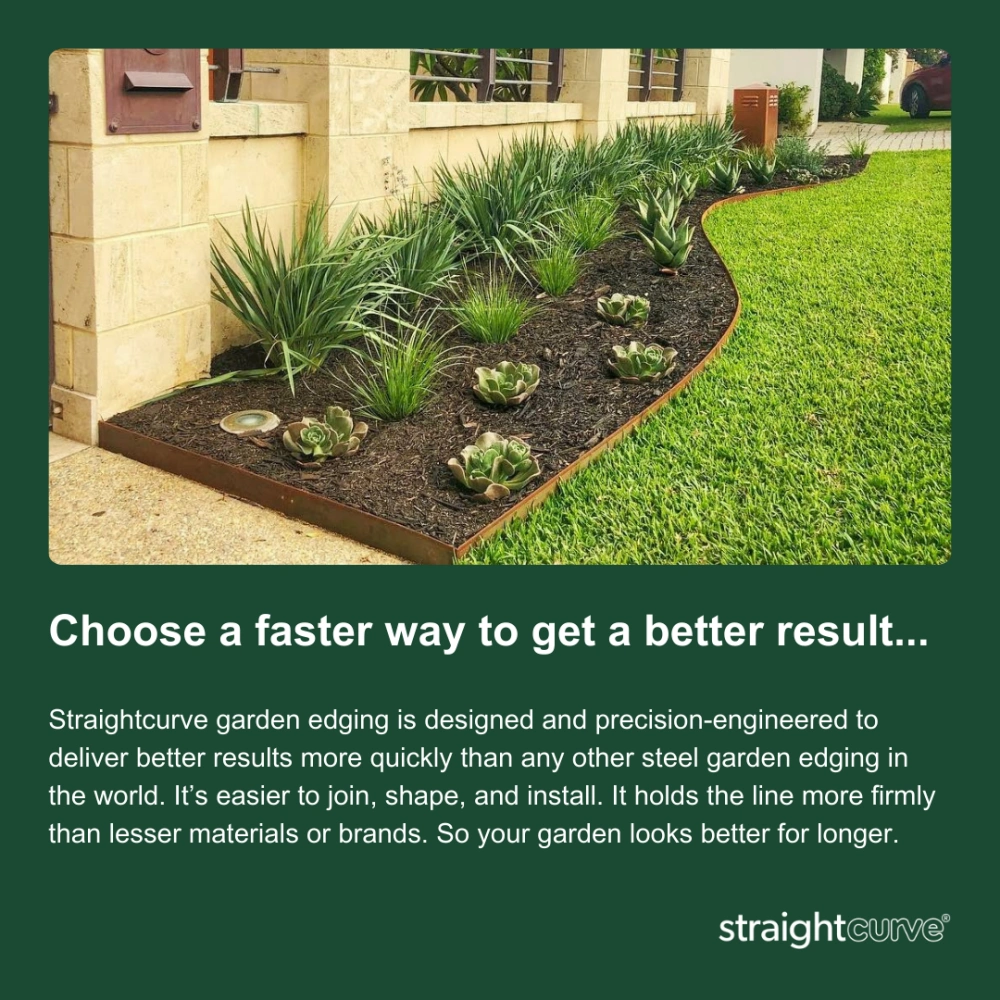
7 Benefits Of Garden Edging.
Garden edging is an important tool for designing any garden or landscaping project because it defines the shape & form of a space. On a practical note, garden edging also helps to separate different elements in the garden whilst providing the structure for curves, angles, and straight lines. Additionally, it controls grass runners, secures mulch and soil, and protects the roots of plants and trees. Here are seven benefits:
1. Establishing Structure:
You may think of garden edging as a finishing touch, but in a garden that’s being overhauled or landscaped from scratch, edging is often one of the first elements to be installed on bare earth to establish the boundaries of different materials or zones. Smart gardeners and landscapers usually set edging in place and then lay lawn up to the border, or backfill mulch up to the boundary lines created by the edging.
2. Maintaining Sharp Lines:
Once installed, the primary job of garden edging is to stay in place, hold the line, and keep materials separated along those boundaries. In this respect, the best edging is designed to remain sturdy and stay put for years after installation. In the case of steel lawn edging, a good quality product will act as a guide for your mower and help maintain crisp borders. Steel edging also gives you more options for shaping your garden edges; you can easily create flowing curved borders, perfectly straight boundaries, or a mixture of both.
3. Boosting Kerb Appeal:
The most appealing homes in any neighbourhood are those that are well-maintained with immaculately presented gardens. Garden edging is the perfect companion to a well-groomed lawn or a weed-free flower bed because it accentuates the preciseness of the garden borders and makes the space look neat & tidy.
4. Creating Peace Of Mind:
Without sturdy and aesthetically pleasing garden edging, your garden borders will quickly soften as grass tries to push into your flower beds, or mulch gets blown over your garden paths. As the hours of yard work visibly build up it becomes nagging thought every time you walk or drive past your garden. Install a sturdy steel garden edge and garden border creep will be all but eradicated and your garden maintenance reduced to some mowing, pruning, and weeding. Your gardens look better for longer with steel edging installed – it’s one less thing to worry about.
5. Preserving Soil Quality:
Garden edging promotes the health and growth of your flowers, plants, and trees in your garden beds by helping to prevent soil erosion which can dilute soil quality and nutrient density. Edging also acts as a barrier to grass runners and weeds that might otherwise compete for their share of soil nutrients.
6. Reducing Mundane Maintenance Time & Expense:
Whether you take care of your own lawn mowing and edge trimming or employ a gardener to do it for you, installing metal garden edging will significantly reduce the amount of time (money) taken to keep your lawn looking neat and tidy. Quality metal garden edging will guide a lawn mower and negate the need to cut borders every few weeks.
7. To Introduce A Unifying Element To Your Outdoor Areas:
Carefully considered garden designs often split a garden into feature zones or rooms. There may be zones dedicated to outdoor cooking, spaces for relaxing and entertaining, other areas for growing food, and so on. In the context of a multipurpose garden, edging can be used both to separate the spaces and act as a subtle unifying element that visually links each area.
There are as many creative applications for garden edging are there are styles, shapes, and material choices. So, what could they do for you and your garden?
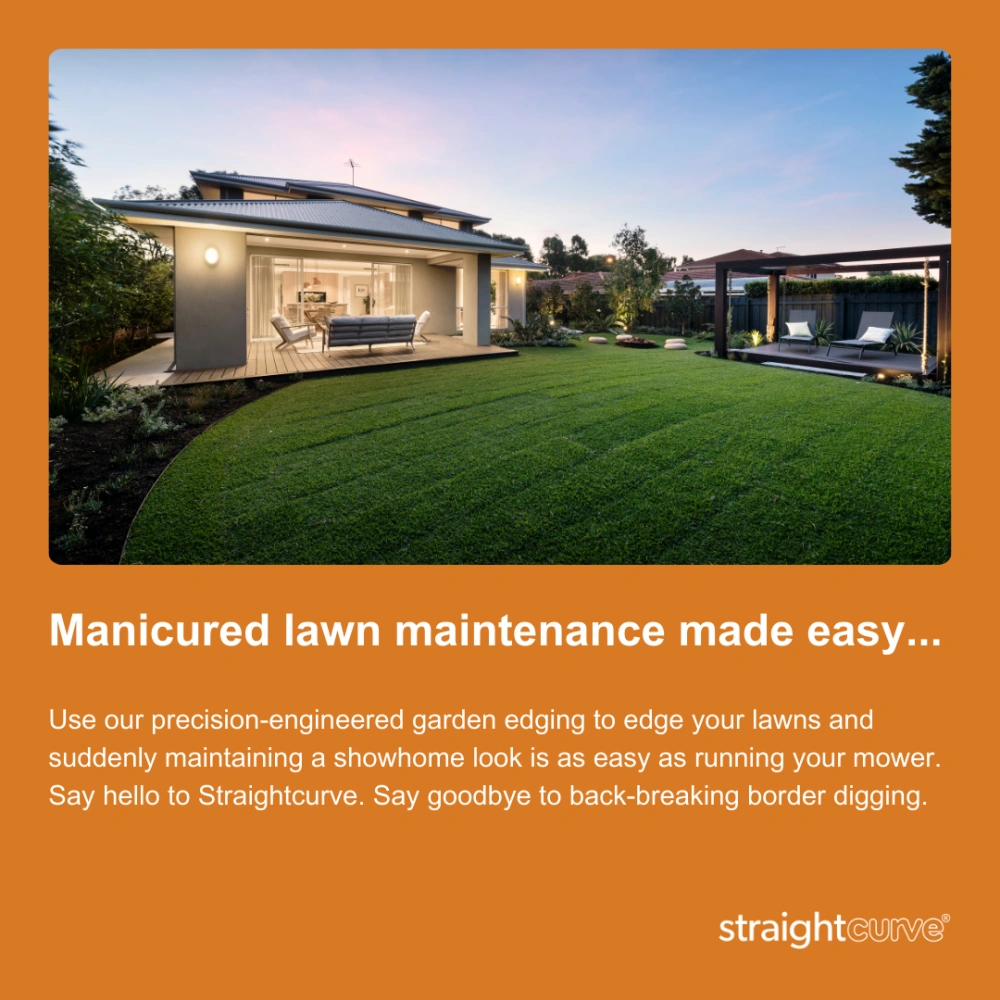
Potential Downsides To Using Garden Edging.
Here are some of the downsides and things to be aware of when considering garden edging:
1. Extra Expense To Buy & Install.
In the short term, adding garden edging to your list of required materials costs more than not using edging at all. That said, it’s often a false economy to leave garden edging off your landscape project shopping list since quality garden edging will significantly reduce the time & money you spend on ongoing maintenance for the years to come.
2. Extra Time & Effort To Install.
It takes time to prepare the ground and install edging, and the time required varies significantly based on the method and product. Installation costs have to be paid in either your own sweat or landscaper labour fees. That said, this is time & money well spent as it will also save you a great deal by reducing ongoing maintenance requirements.
3. Choosing The Wrong Garden Edging Can Make Your Garden Look Worse.
That not all garden edging is made the same is something most people don’t fully appreciate until after they’ve bought, installed, or lived with the product. You can spend hundreds or thousands of dollars on your landscaping project or garden upgrade, only to spoil the overall aesthetic with badly installed or poor-performing edging that makes everything look unfinished. Tip: choose the best edging product your budget will allow to maintain the integrity of your garden design – you’ll thank yourself if you do this and kick yourself if you don’t.
4. Badly Installed And Poor Performing Garden Edging Can Make Routine Maintenance More Difficult.
As soon as you’ve finished your garden makeover (or had it handed over) the next job is to stay on top of your garden maintenance. But if you pick the wrong kind of garden edging, maintenance is more time-consuming! For instance, if you use plastic edging (or any product that’s not designed to stay firmly fixed in place), there’s a good chance it will shunt, twist, or otherwise move out of alignment as roots push into it, your mower nudges it, or clumsy feet kick it. If you want your garden to look neat & tidy for years, look for an edging product designed to stay true.
5. It Will Need To Be Replaced (In Some Cases Sooner Than You Might Expect).
Over time, and with enough exposure to the elements, all garden edging materials will eventually need replacing. However, the lifespan of garden edging varies considerably between materials and brands. If you want your garden to look neat & tidy for years, look for an edging product made to last.
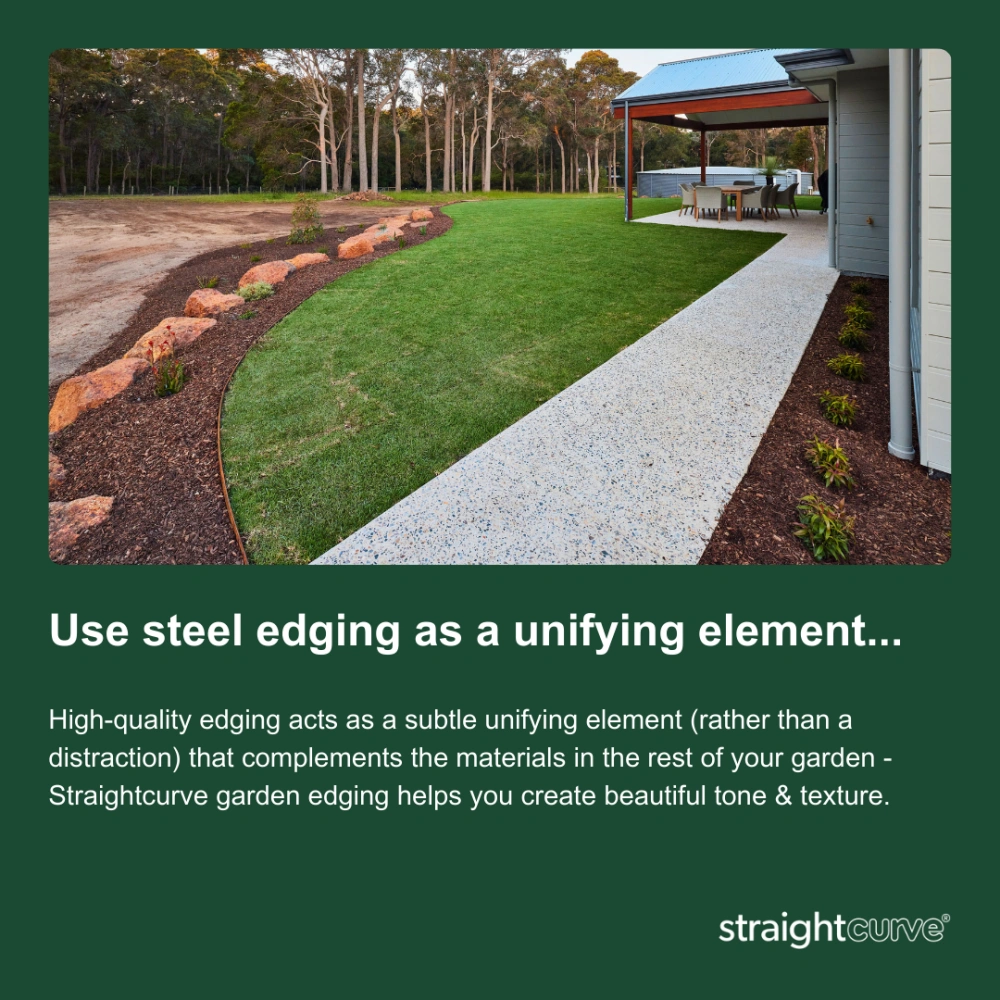
Materials: What Are The Best Materials For Garden Edging?
You can create garden borders and landscape edging with all sorts of materials – here are some of the more popular options, complete with a list of their Pros & Cons.
1. Brick:
Pros – A very durable material available in various styles that can create a cohesive appearance. Cons – Requires skill to install properly, mortar lines can crack and look messy over time, tricky to repair or replace.
2. Pavers:
Pros – Made from concrete which is highly durable. However, they can be labour-intensive to handle and install, requiring a few days of heavy lifting and excavation. Cons – Heavy, time-consuming, prone to shifting.
3. Plastic:
Pros – Plastic edging is lightweight and comes in various grades which can make it very affordable and relatively easy to install. Cons – Often not very user-friendly, warps and cracks relatively quickly with exposure to the elements, most prone to shunting, needs replacing more often than any other material choice.
4. Concrete:
Pros – Concrete landscape edging can be purchased preformed and ready to slot into place or custom-made using a form. Cons – Can look bulky and old-fashioned, can be prone to cracking, can be prone to shifting by invasive roots and grasses.
5. Wood:
Pros – Wood is a practical option for creating straight borders with a natural and relaxed aesthetic. Cons: Unsuitable for curving borders, can warp, rot, splinter, attract termites, and present a fire hazard in bushfire-prone areas.
6. Metal:
Pros – Metal edging is very versatile and suitable for perfectly straight or smoothly curving garden and pathway borders. Metal garden edging is available in the form of aluminium, various kinds of steel, and even powder-coated metal. It comes in various heights for edging garden beds or constructing raised beds. Cons – Can be tricky to install if you choose a product that has not been designed with user-friendliness in mind.
7. Natural Edging:
Pros – An alternative option for creating a neat edge in your lawn is to use an edging shovel, spade, or electric edger to cut away the grass, preventing it from encroaching into flower beds. Cons – This technique is labour-intensive and needs to be done regularly if you want everything to look neat.
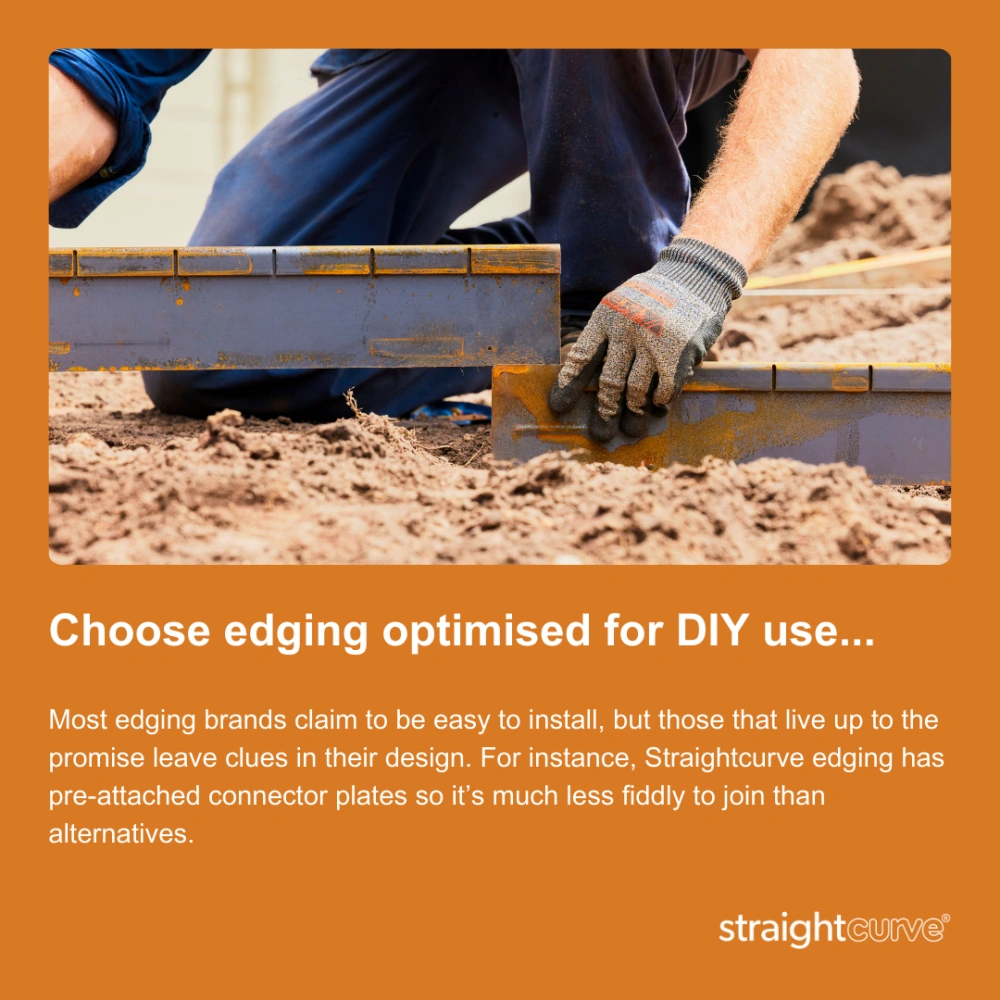
Metal Garden Edging: Which Metals Are Best For Garden Edging?
Not all metals are suitable for outdoor use and each type has pros & cons.
1. Aluminium:
Pros – Creates a contemporary look that can complement modern minimalist-designed homes. It’s also very lightweight and relatively easy to install. Cons – Aluminium is a soft metal that bends and kinks so it’s not ideal in highly trafficked areas such as driveways or lawn borders that will be mowed.
2. Mild Steel:
Pros – Looks good in the short term and is a cheap alternative to galvanised or weathering steel. Cons – Mild steel rusts, flakes, and otherwise fails with exposure to the elements so avoid it if you don’t want to replace your edging every few years.
3. Galvanised Steel:
Pros – Extremely hardwearing and especially suitable for gardens near coastal areas with high atmospheric salt content. Galvanised steel edging is also ideal in gardens watered with bore water which is more corrosive than mains water. Cons – Creates a contemporary look & feel which may not suit a more rustic garden design.
4. Weathering Steel:
Pros – Weathering steel (also known as Corten) is a unique alloy that’s more durable than mild steel. This kind of steel develops a rust-like appearance when exposed to the elements, creating a stable and unique finish. The natural weathering process gives the steel a rustic look that blends well with garden foliage. Cons – Will erode more quickly in gardens using acidic bore water.
5. Powder-coated Steel:
Pros – Usually made from mild steel, with a zinc coating and a plasticised paint, this sealed product lasts much longer than any other steel edging (provided a quality powdercoat is used). Powdercoating also opens up a world of colour options. Cons – Not all powdercoats are made equal, lesser quality powdercoats can crack or flake, which makes them susceptible to rusting. Some powdercoated steel looks artificial compared to the natural patina of weathering steel, but that’s a personal preference.
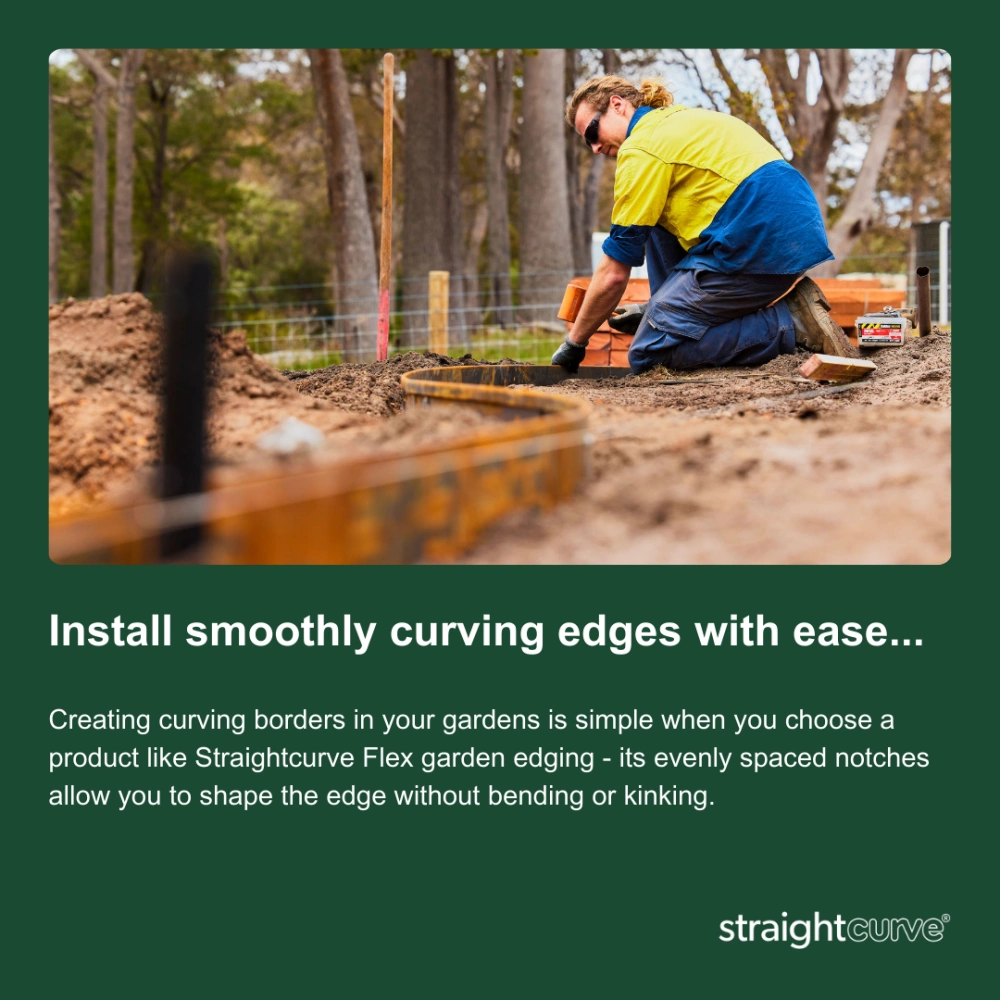
What To Look For When Choosing Sizes, Shapes, And Styles Of Steel Garden Edging.
Some garden edging products or brands have a one-form-fits-all approach. For instance, you might find a pre-rolled plastic edging product that’s marketed as equally suitable for straight edges as curving borders. More user-friendly and application-specific products or brands will offer a range of products optimised for particular uses – this is the case with the Straighcurve Flex, Rigid, and Zero-Flex garden edging products.
Here’s a list of items to consider to get the best results:
1. Designed for smooth curving lines (designed for controlled flexibility)
If you want flowing curved borders in your garden, look for edging that’s optimised for this purpose. In the case of Steel Garden Edging, look for evenly spaced notches along the top edge as they will create even curves and avoid kinking that can spoil the effect.
2. Designed for a mix of mostly straight plus gentle curves (designed for rigidity)
If you want garden edges that can hold a straight line and be fashioned into a gentle curve, look for a product designed accordingly. In the case of Steel Garden Edging, look for a folded top edge without notches since this promotes greater rigidity whilst allowing a gentle flex.
3. Designed for perfectly straight lines (designed for straightness & strength)
If you want a perfectly straight garden edge, look for a product that’s specifically optimised for that application. In the case of Steel Garden Edging, look for a product with a double-sided foot that maximises positional stability and an integrated joining system that makes it virtually impossible to shunt or buckle.
4. Designed to look like a continuous, unbroken line (designed for neat joins)
If you want your garden edge to hold a line and maintain the form of your ground-level gardens without drawing undue attention to itself, look carefully at how the product is joined. Some products have very obvious or ugly joins that stand out for the wrong reasons, whereas a well-designed joining system is practically invisible.
5. Designed to create a contemporary or organic look & feel (designed for a refined aesthetic)
If you want a rustic, organic, or natural aesthetic then the earthy patina of weathering steel garden edging (aka CorTen) will suit. Alternatively, if you prefer a more contemporary look, then galvanised steel garden edging would be a better option (with the added bonus of being paintable in any outdoor paint colour – so you could match or contrast your boundary fencing).
6. Designed to last for a season, for several years, or a lifetime (material quality)
The structural integrity of the garden edging you choose will vary considerably between materials and brands. So measure the suitability of your choice of material or product in terms of how long it will stay together, hold in place, and keep your garden looking sharp.
7. Designed hide or stand out (edging heights)
The primary function of garden edging is to hold a defined line or act as a barrier to separate materials, rather than draw attention to itself. That said, it’s a matter of personal preference as to how much edging is on show, and that’s one of the reasons garden edging is available in different heights (e.g.75mm, 100mm, and 150mm). The other reason you might choose taller edging is to sink it deeper into the ground to deal more effectively with invasive grasses.
8. Designed to stay in place (no shunt)
The way edging is positioned and held in place varies between materials and brands, and some methods are better than others for keeping your borders intact and true. Consider (or ask) how your chosen brand of edging is held in place and whether it could be susceptible to shunting, cracking, buckling, or other failures that would require attention, repair, or replacement.
9. Designed for quick and versatile installation (easy connections and variable fixing)
Every brand or method may claim to be quick and easy to install. Of course, it’s usually a subjective claim (easy for some) or comparative claim (easy compared to other methods). The issue here is, especially in the case of a first DIY gardening project that requires edging, you probably don’t have anything to compare it to. Look out for installation videos that show (rather than tell) you how easy it is whilst pointing out some of the design features that make it quick & easy.

Extra Considerations: Before Buying + Installing Garden Edging.
1. Consider If Your Choice Of Edging Material Will Complement The Rest Of Your Garden Scheme.
If the overall aesthetic of your garden is important to you (or potential future buyers of your property) it’s a good idea to choose edging that will be a unifying element rather than a distraction. For instance, if the materials you’ve used elsewhere in your garden have a natural colour palette, garden edging with a weathering steel (aka corten) finish will work well. In contrast, shiny, galvanised steel will pair well with a more contemporary garden aesthetic and garden furniture.
2. Consider How Effective Your Choice Of Edging Will Be.
Good quality edging will define the shape of your garden. It will form a barrier to prevent grasses from creeping into your garden beds and stop mulch from scattering over pathways. Quality garden edging will stay firmly in place and hold your boundaries. Poor quality edging on the other hand will not perform these jobs effectively.
3. Consider How Long You Want Your Edging To Last Before It Needs Replacing.
Not all edging is made to last so consider how often you’re prepared to fix, reset, or completely replace your edging when you choose between materials and brands. For instance, most plastic garden edging though cheap to purchase initially, may crack, warp, or shunt within a year or two of installation. A high-quality steel equivalent on the other hand can last a decade or more.
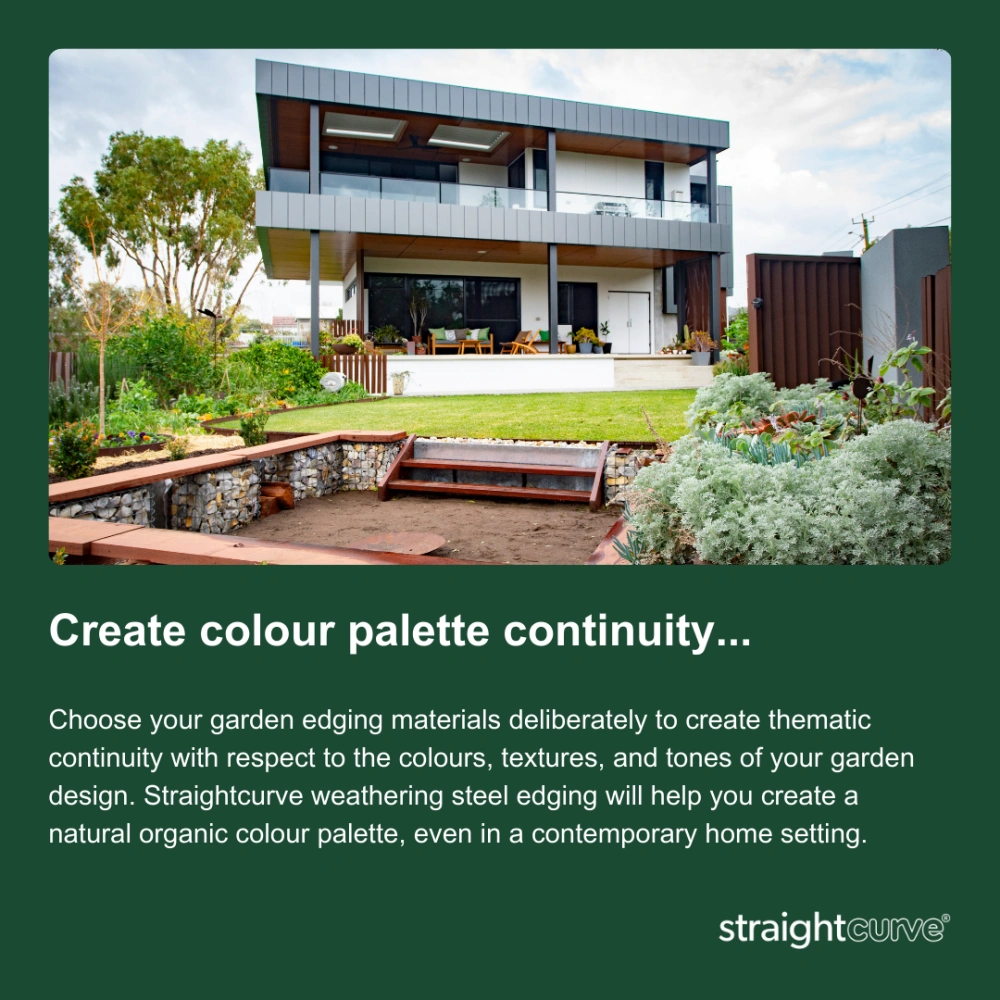
Installation: How To Install Steel Garden Edging (Step-By-Step Installation Videos)
Here are three short installation videos showing how straightforward it is to install steel garden edging when you choose a product that’s optimised for quick & easy installation. Notice that there are slightly different products for curving borders compared to gardens with perfectly straight edges.
Straightcurve “Flex” Garden Edging:
Straightcurve “Rigid” Garden Edging:
Straightcurve “Zero-Flex” Garden Edging:
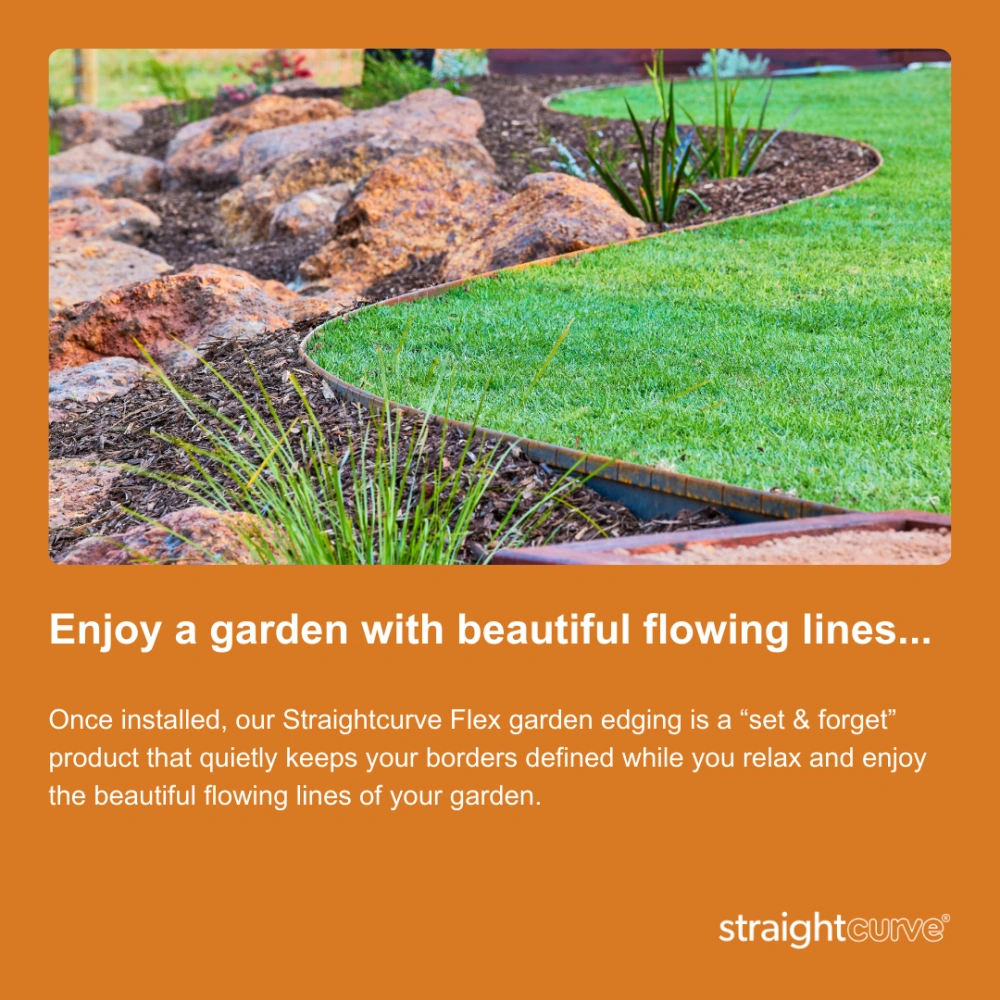
Comparing Edging Brands – Is All Steel Garden Edging The Same?
The Straightcurve garden edging range was born of the desire to make a reliable product that would be super easy to use, do the job brilliantly, and overcome some of the limitations of other products on the market. We’ve spent more time than we want to admit thinking about, designing, prototyping, and improving our products to make them Simply Better and smarter than anything else on the market, anywhere in the world.
You might think – “Is there really that much of a difference between the brands of steel garden edging – and do those differences actually matter?”
We say yes.
And once you see the differences, you’ll be glad you spotted them before purchasing anything. I wouldn’t expect you to geek out on the details like us, but when it comes to comparing our products to others you’ll find online (or in your local hardware store), it’s useful to be aware of the following:
1. Fixed Spikes May Seem Convenient But Can Be Problematic During Installation.
If you have any obstacles in the ground (rocks, roots, retic, etc) there’s no way to avoid them if you’re using a product with spikes formed into the edge. That’s why we designed our garden edging with movable pegs / spikes, so you can easily move the stake around the obstacle.
2. Most Steel Edging Will Not Flex Evenly.
Unless you’re skilled, you might find it difficult to curve some steel garden evenly without bending or kinking it – which doesn’t look great. We factored this into our Flex Garden edging by adding notches on the inside of the folded lip to allow you to create smoothly flowing curves.
3. The Joining Detail Can Make Or Break The Look.
Other brands of steel garden edging have a joining system that can look quite clumsy when using a sleeve-style connector or overlapping notches. Whilst steel edging is not as visible as steel retaining or raised beds, it can draw the eye in an annoying way where the joins interrupt the line. We designed our joining systems with a preattached connector plate which makes our edging virtually seamless. It’s a small but very noticeable difference.
4. Single-Thickness Steel Edging Has Sharp Edges That Can Harm Bare Feet, Ungloved Hands, Or Paws.
We knew this going into the design process, so we gave our edging a double-folded top edge to make it safer for all garden users. When comparing Straightcurve to any other metal edge, check for sharp edges on the top edge or at the joins.
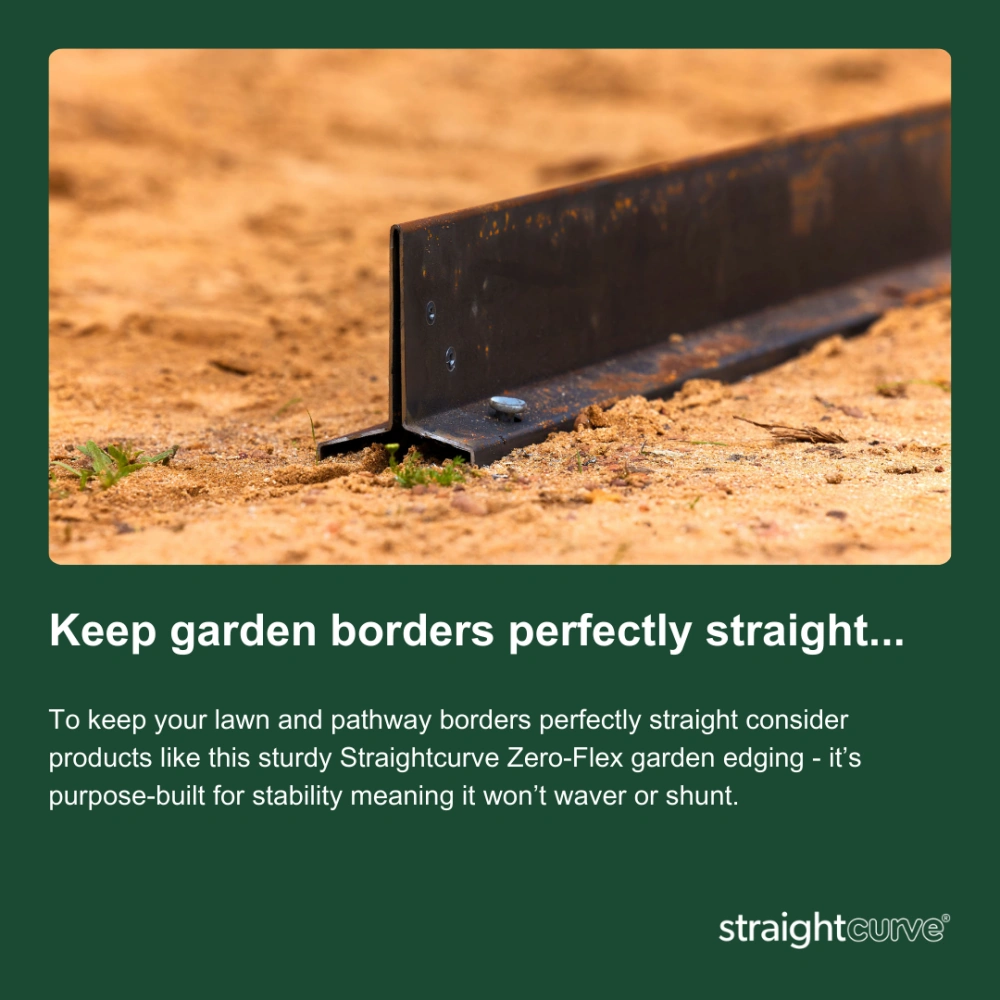
Checklist: How To Pick Your Perfect Option.
As you’ve seen, there are so many kinds of garden edging – it could feel a little overwhelming to decide which is the perfect option.
The truth is, there is no one universally perfect option – it’s about finding the option that works best for you. Which is about being clear on certain things like; whether you’re chasing pure functionality or looking for a particular aesthetic, what your budget is, whether you want to install something that lasts for years, or if something more temporary would suffice.
Here are some questions to ask yourself:
– Are you chasing a particular look & feel?
– Do you have a material preference?
– What materials are you keeping separate?
– Do you have a limited budget?
– Are there termites in your area?
– Is your home and garden in a dry or humid climate?
– Will children and pets have access?
– How long do you want your edging to last and look good?
– Will the borders you install be highly visible?
– Should your garden edging improve the kerb appeal of your property?
– Do you want to get hands-on with this project or would you prefer to leave it to a professional?
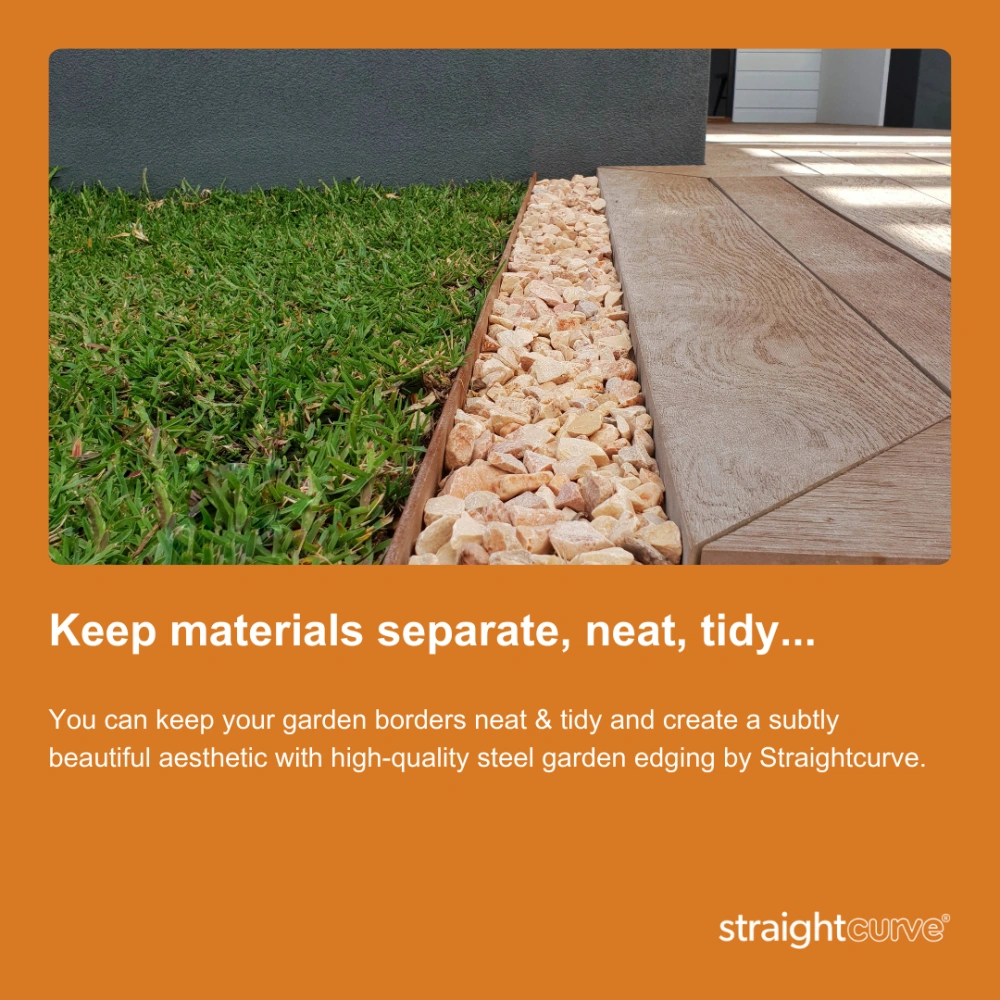
Why People Choose Straightcurve Garden Edging?
If you spend time researching steel garden edging online, you’ll find that most brands say more or less the same thing. And that isn’t very helpful if you’re trying to compare options.
Most brands will say their edging products are; high-quality, durable, seamless, easy-to-install, and aesthetically pleasing.. And to some extent this is true. But it’s not true to think “If I’ve seen one type of garden edging, I’ve seen them all”.
Ultimately, the brand or product you choose boils down to whether you want to make-do with garden edging that will work reasonably well until it doesn’t, or if you’d prefer to buy a product that’s a pleasure to work with and live with. Here are the top 10 reasons why people prefer Straightcurve Steel Garden Edging over any other brand:
1. Extremely High Quality:
Our garden edging products are high-quality steel with a galvanized or weathering steel finish. Both types of steel are extremely hard-wearing and can last for 10 years or more. All our products precision-engineered, stylish, and aesthetic. pleasing.
2. Quick To Connect:
Our garden edging fits together neatly via discreet joining systems, creating beautiful, almost seamless joins.
3. Aesthetically Pleasing:
Our weathering steel garden edging has a rustic look that changes over time as the natural patina develops. Meanwhile, our galvanised steel products will lend a contemporary to your garden borders. All our products have rolled edges with a smooth and safe profile.
4. Easy To Shape By Hand:
For circular or curved garden borders, our Straightcurve Flex 75mm, 100mm, and 150mm range is easy to shape by hand. It also gives you almost unlimited flexibility in design and installation.
5. Purposefully Designed:
Our garden edging is quickly and easily installed with basic household tools because we supply it pre-drilled and prepared for self-assembly.
6. Hard Wearing:
Our garden edging (most especially our Zero-Flex range) is incredibly sturdy and won’t budge once installed, thanks to our unique stabilising, joining, and fixing systems.
7. Adaptable to Onsite Changes:
Our garden edging adapts to onsite changes, which makes it a versatile choice for various garden designs.
8. Simple to Install:
Follow the simple instructions in our installation videos to edge your borders in hours.
9. Suitable for All Soil Types:
Our garden edging is suitable for all soil types and garden environments.
10. Ready When You Are:
Start whenever you’re ready by sourcing Straightcurve from our network of landscape supply dealers across Australia.
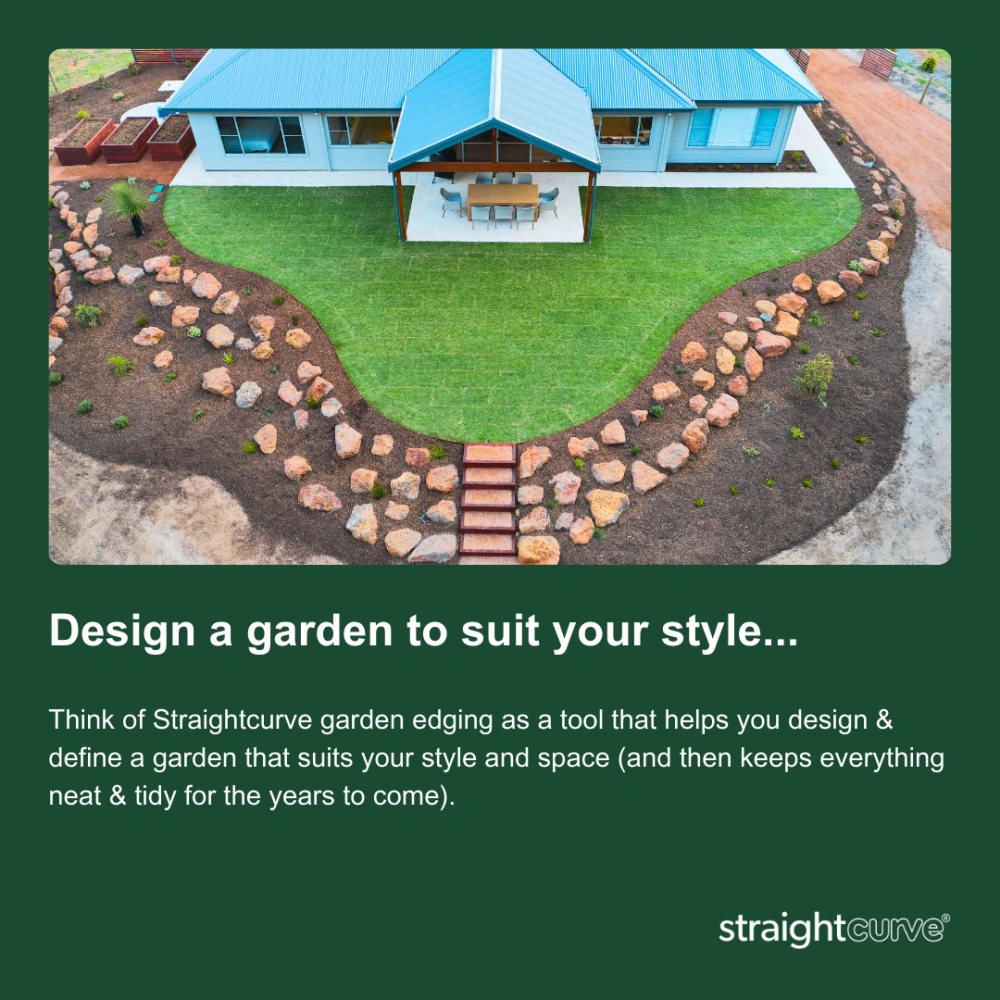
The Impact of Steel Garden Edging On Kerb Appeal + Property Value.
Most Landscapers and Home Gardeners will install or retrofit steel garden edging to keep borders well-defined and make ongoing garden maintenance quicker & easier. A lesser-known reason to use steel edging in your garden is to boost its kerb appeal and desirability. This is especially relevant if you’re considering selling or renting your property.
You’ve likely seen (or at least heard of) the many garden makeover TV shows where the crew take a tired old garden and breathe new life into it with the help of a redesign and / or some simply tweaks that collectively make a world of difference to the overall look & feel. The before and after shots never fail to impress. In some shows the property is valued before and after the makeover to demonstrate the (often significant) dollar value of undertaking a garden overhaul.
Lawns, flowers, feature trees, and structural features (e.g. gazebos) create a big visual impact in a garden makeover. However, the hidden hero of the garden is often barely visible garden edging that defines (and maintains) the shape, form, and structure of the various aspects of garden.
Just as a garden designer will plan a garden overhaul by sketching out the lines and defining the spaces, the landscape installation team will deliver that plan using garden edging to establish and set borders & boundaries.
Garden edging is not as flashy and eye-catching as many of the other introduced materials of a garden overhaul, but it is often the backbone of the entire design.
It’s a bit of a contradiction, but when done well, garden edging is the one product that ties a garden design together, whilst keeping everything separate and distinct. And it’s one of the simplest ways to boost the look & feel of your garden, whilst adding value to your home.

Next Steps & Recommendations:
- Decide on the purpose of your garden edging. Do you want to shape & define your garden borders or add visual interest and keep your garden tidy? Do you want to increase your property’s kerb appeal or simply make maintenance easier?
- Do some online research. Find examples you like the look of. Get a sense of how easy to install, how costly to setup, how likely to last, and how suitable they would be for your garden.
- Visit nearby garden centres and landscape suppliers to look for and price up some options. If you’d like to talk to someone about Straightcurve garden edging products, reach out to your nearest Australian dealer to talk about the options.
- Decide whether you want to build yourself or hire a professional. If you go the DIY route, talk to our dealers about what you’ll need and check out our installation videos. If you’re going to hire a professional, ask your local landscape supply store (or Straightcurve stockist) to recommend a professional landscaper or designer.
NOTE: If you’re a landscape professional and you’d like to find out more about our range, visit our Trade page, enquire about a PRO account, or find our nearest stockists.
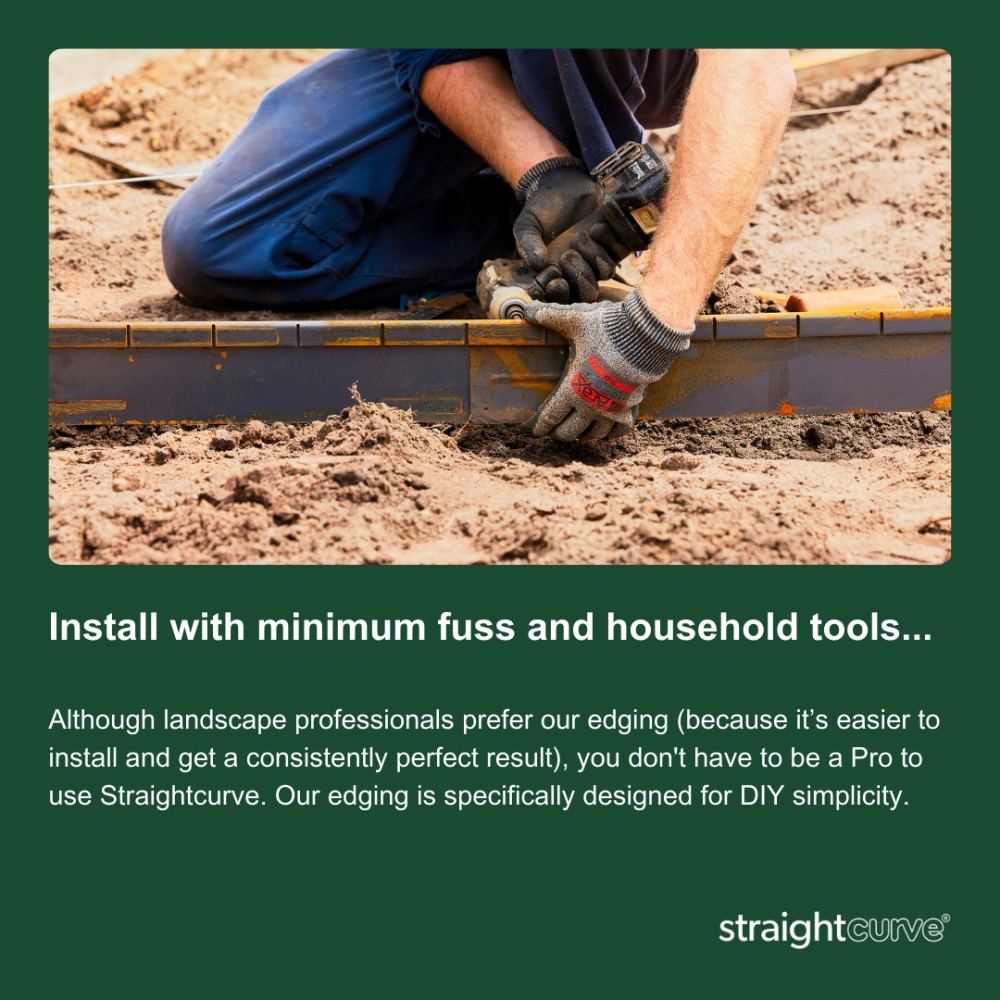
Conclusion:
I hope you found this guide useful and that it helps you choose the best garden edging for your needs.
Please help yourself to the resources on our website and the useful links listed below.
And finally good luck with your garden edging project.
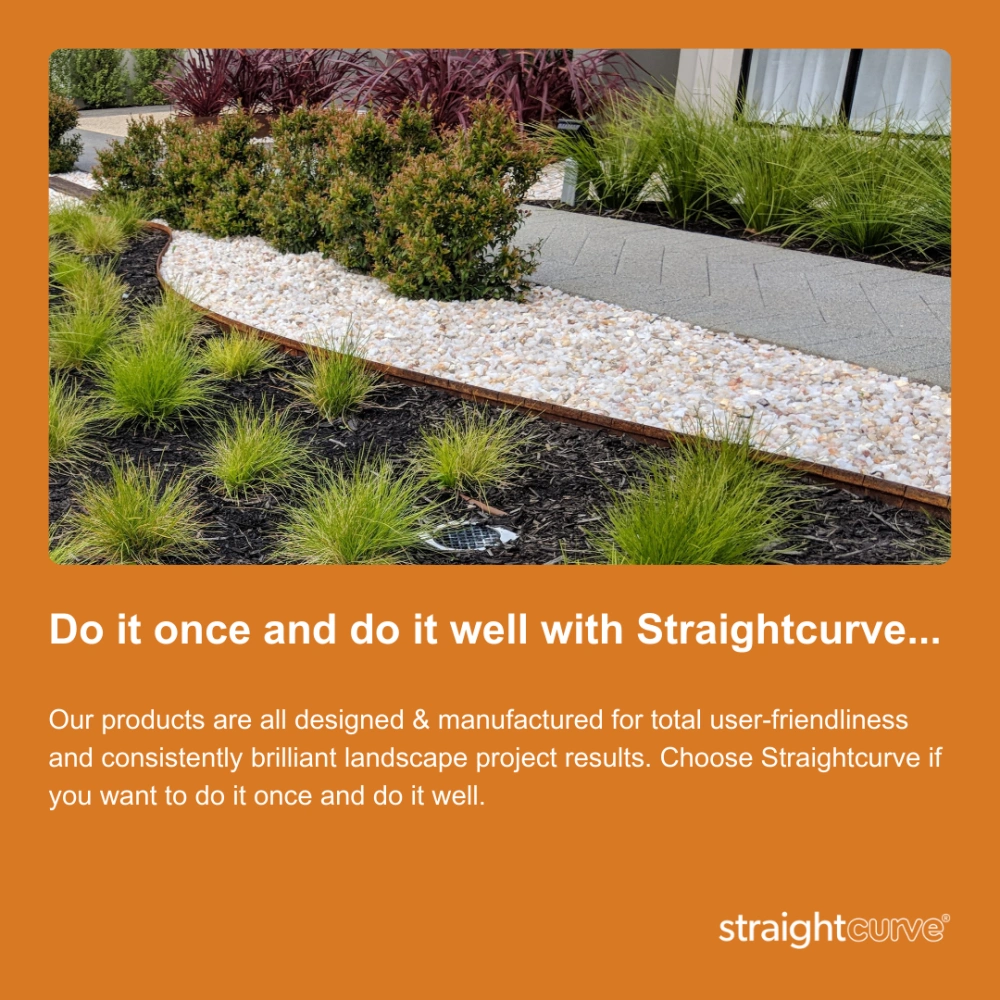
Helpful Resources:
Use the linked resources below to see whether our steel garden edging would suit your project:
- Download Our Product Catalogue – Download the pdf and skip to the Garden Edging section.
- Check Out Our Image Gallery – Here you’ll find examples of garden edging using our products.
- Introduction Video – Watch this video to see which style of product might work for your project.
- View Installation Videos – Here you’ll discover how easy it is to build raised garden beds yourself.
- Find Your Nearest Dealers – Find stockist locations and contact details on our “Where To Buy” map.
- Request Pricelist & Brochure – Submit to receive a brochure, pricelist, and stockist’s details by email.
